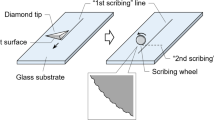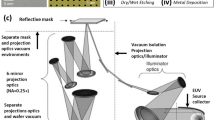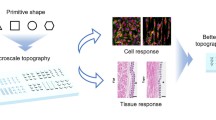Abstract
This paper reports on the fabrication and test of a micro-tool for in vitro cell array manipulation. The device consists of a micro-post array with supporting pillars which can be used to apply simultaneous mechanical force to all elements of a cultured cell array. The mechanical pulling force has been shown to initiate neurite outgrowth, thus allowing one to potentially engineer a large living neural network having defined connectivity. In order to realize this goal, the designed micro-tool must have some important features. For example, it must be transparent to allow visual access through a light microscope. It must also have a gap of 3–5 μ m between the tips of the posts and the culture dish to avoid post breakage and to allow matching the height of individual cells. We have used silicon bulk micromachining and anodic bonding to fabricate the micro-post array having the required features. The micro-tool reported in this paper has overall dimensions of 5×5 mm2, which includes an array of 2,500 posts (5×5 μ m2) supported by four pillars (600×600 μ m2). The posts are made from a SiO2/Si3N4 sandwich while the pillars have an additional silicon layer for extra support. The micro-tool was tested on randomly seeded embryonic chick forebrain cells. Moving the micro-post array relative to the cell culture substrate at a constant speed of 36 μ m/hour resulted in several neurite-like cytoplasmic processes that were initiated and elongated from cells that had adhered to the posts.
Similar content being viewed by others
References
A.A. Ayón, R. Braff, C.C. Lin, H.H. Sawin, and M.A. Schmidt, J. Electrochem. Soc. 146, 339-349 (1999).
D. Bray, Developmental Biology 102, 379-389 (1984).
P.K. Campbell, K.E. Jones, and R.J. Huber, IEEE Trans. Biomed. Eng. 38, 758-768 (1991).
S. Chada, P. Lamoureux, R.E. Buxbaum, and S.R. Heidemann, J. Cell. Sci. 110, 1179-1186 (1997).
K. Chun, G. Hashiguchi, H. Toshiyoshi, and H. Fujita, MEMS'99 406-411 (1999).
J.P. Den Hartog, Strength of Materials (Dover Publications, 1977).
T.J. Dennerl, H.C. Joshi, V.L. Steel, R.E. Buxbaum, and S.R. Heidemann, The Journal of Cell Biology 107, 665-674 (1988).
J.N. Fass and D.J. Odde, Biophys. J. 85, 623-636 (2003).
J.G.E. Gardeniers, J.W. Berenschot, M.J. de Boer, Y. Yeshurun, and M. Hefetz, MEMS'02 141-144 (2002).
L. Griscom P. Degenaar, B. LePioufle, El Tamiya, and H. Fujita, Transducers'01 338-341 (2001).
G.W. Gross, B.K. Rhoades, H.M.E. Azzazy, and M.-C. Wu, Biosensors and Bioelectronics 10, 553-567 (1995).
J.A. Hammarback, J.B. McCarthy, S.L. Palm, L.T. Furcht, and P.C. Letourneau, Developmental Biology 126, 29-39 (1988).
S.R. Heidemann, P. Lamoureux, and R.E. Buxbaum, J. Cell Biol. 111, 1949-1957 (1990).
M.O. Heuschkel, L. Guerin, B. Buisson, D. Bertrand, and P. Renaud, Sensors & Actuators B 48, 356-361 (1998).
H. Jansen, M. Boer, R. Wiegerink, N. Tas, E. Smulders, C. Neagu, and M. Elwenspoek, Microelectronic Engn 35, 45-50 (1997).
Y. Jimbo, H.P.C. Robinson, and A. Kawana, IEEE Trans. Biomed. Eng. 40, 804-810 (1993).
P. Lamoureux, R.E. Buxbaum, and S.R. Heidemann, Nature 340, 159-162 (1989).
L. Lauer, S. Ingebrandt, M. Scholl, and A. Offengausser, IEEE Trans. Biomed. Eng. 48, 838-842 (2001).
D.V. McAllister, F. Cros, S.P. Davis, L.M. Matta, M.R. Prausnitz, and M.G. Allen, Transducers'99 1098-1101 (1999).
H.P. Neves, R.H. Goldsmith, A.W. Degolyer, G.D. Bachand, J.J. Schmidt, and C. D. Montemagno, Transducers'01 1086-1088 (2001).
B.A. Parviz and K. Najafi, J. Micromech. Microeng. 11, 277-282 (2001).
R. Singhvi, A. Kumar, G.P. Lopez, G.N. Stephanopulos, D.I.C. Wang, G.M. Whitesides, and D.E. Ingber, Science 264, 696-698 (1994).
B.C. Wheeler, J.M. Corey, G.J. Brewer, and D.W. Branch, Journal of Biomechanical Engineering 121, 73-78 (1999).
T. Yoshioka, T. Ando, M. Shikida, and K. Sato, Sensors & Actuators A 82, 291-296 (2000).
J. Zheng, P. Lamoureux, V. Santiago, T. Dennerll, R.E. Buxbaum, and S.R. Heidemann, J. Neurosci. 11, 1117-1125 (1991).
J. Zheng, R.E. Buxbaum, and S.R. Heidemann, J. Cell Sci. 104, 1239-1250 (1993).
Author information
Authors and Affiliations
Rights and permissions
About this article
Cite this article
Baldi, A., Fass, J.N., Silva, M.N.D. et al. A Micro-tool for Mechanical Manipulation of in vitro Cell Arrays. Biomedical Microdevices 5, 291–295 (2003). https://doi.org/10.1023/A:1027353612618
Issue Date:
DOI: https://doi.org/10.1023/A:1027353612618




